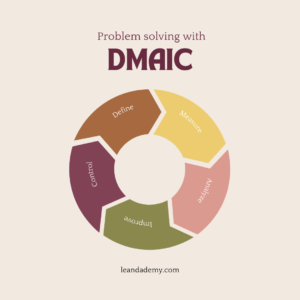
- Define
- Measure
- Analyze
- Improve
- Control
PROBLEM-SOLVING with DMAIC
In the dynamic landscape of process improvement, the DMAIC methodology shines as a beacon for problem-solving. Whether you’re a seasoned Lean Six Sigma practitioner or simply curious about enhancing business processes, understanding problem-solving with DMAIC is paramount. In this article, we’ll explore each step of the DMAIC cycle and learn how to apply it within your organization effectively.
Define: Define the Problem
The Define Phase sets the stage for your project. Here’s what you need to do:
- Project Charter: The project charter clearly defines the project’s business, problem, and goal statements.
- Project Scope: Clearly define the project boundaries.
- Goals: Understand your objectives. Are you aiming to reduce defects, improve lead times, or enhance productivity?
- Tools: Project Selection, Pareto Chart, Project Charter, and SIPOC
Measure: MEASURE the Problem
In the Measure Phase, data and process mapping become your ally:
- Process Mapping: Basis for the DMAIC problem-solving approach
- Graphical representation of the process
- Data Collection: Gather measurable data related to the process, such as cycle times, defect rates, or other relevant metrics.
- Measure the problem: Measure the process with control charts and process capability to determine the current state of the process and problems
- Tools: Measurement Systems Analysis, process map, Value Stream Map, Input Maps, Control Charts, Process Capability
Analyze: Analyze the problem
Dig deep to understand what is causing the problem
- Root Cause Analysis: Investigate the reasons behind process inefficiencies. Isolate the root causes to find the critical few Xs.
- Tools: Graphical analysis, Cause and effect, FMEA, statistical analysis
Improve: Improve the Probelm
The Improve Phase is about solutioning, implementing solutions, and optimization:
- Solution Design: Brainstorm potential solutions. Prioritize based on impact and feasibility.
- Pilot Implementation: Test your chosen solution on a small scale. Gather feedback and refine as needed.
- Full Deployment: Roll out the improved process across the organization.
- Tools: Lean Thinking, Brainstorming, Implementation Plan, Control Charts, Prioritization Matrix, Value Stream Map, process maps
Control: Control and Sustain the GAINs
Ensure lasting improvements and Continuous Improvement:
- Standardization: Document the improved process. Create standard operating procedures (SOPs).
- Monitoring and Feedback: Continuously monitor performance. Address deviations promptly.
- Training: Train team members to maintain the new process.
- Control: Setup a control plan to monitor the process to ensure corrective action is taken
- Celebrate: Celebrate the project success and your Team!!!!!!
- Tools: SOPs, Control Plan, Control Charts, training plans
Conclusion
DMAIC empowers organizations to systematically identify and eliminate waste, leading to significant improvements in efficiency, quality, and customer satisfaction. Remember, DMAIC isn’t just a methodology; it’s a mindset—a commitment to continuous improvement.
Do you want to learn more about DMAIC? Check out our training options.
If you want more information, please fill out our Contact Form.
Follow us on YouTube.
Follow us on LinkedIn.
